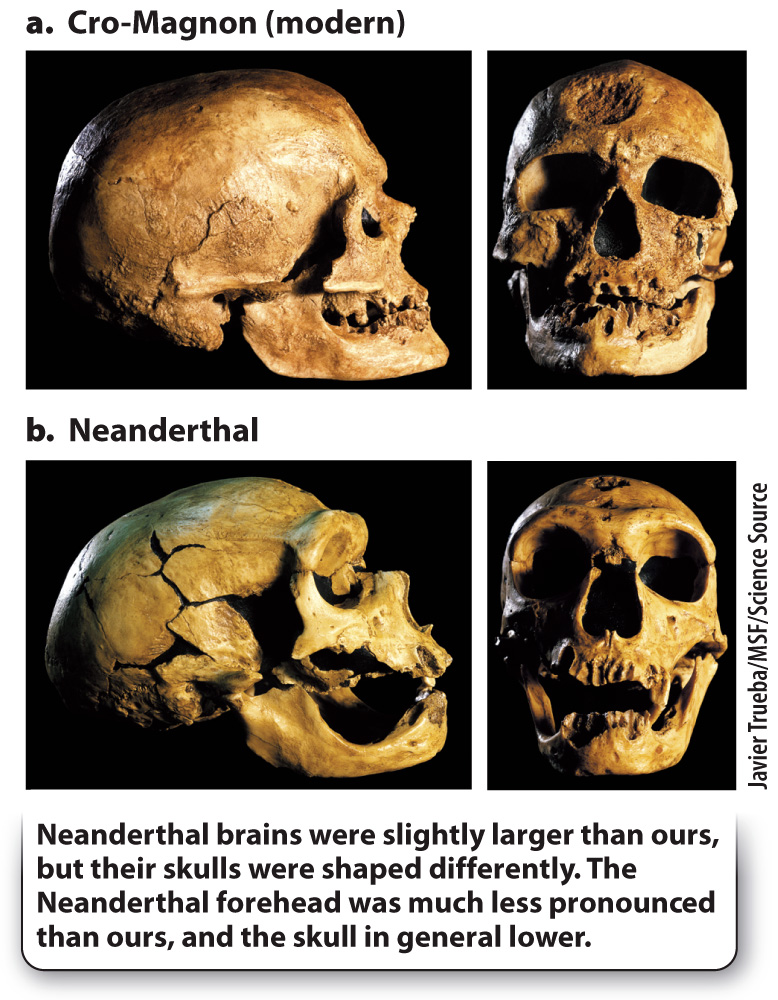Neanderthals disappear from the fossil record as modern humans appear, but have contributed to the modern human gene pool.
If we exclude H. floresiensis, the last of the nonmodern humans were the Neanderthals (Fig. 24.9), who lived in Europe and Western Asia until about 30,000 years ago. What happened? Were they eliminated by the first population of Homo sapiens to arrive in Europe (a group known as Cro-Magnon for the site in France from which specimens were first described)? Or did they interbreed with the Cro-Magnons, and, if so, does that mean that Neanderthals should be included among our direct ancestors? Indeed, if modern humans interbred with Neanderthals and our definition of species is based on reproductive isolation (Chapter 22), perhaps we should consider H. sapiens and H. neanderthalensis as belonging to the same species.

FIG. 24.9 (a) Homo sapiens and (b) Homo neanderthalensis. Neanderthals disappeared from Europe about 30,000 years ago, about 10,000 years after a group of modern humans called Cro-Magnon first appeared in Europe.
In 1997, we thought we had a clear answer. Matthias Krings, working in Svante Pääbo’s lab in Germany, extracted intact stretches of mtDNA from 30,000-year-old Neanderthal bone. If Neanderthals had interbred with our ancestors, we would expect to see evidence of their genetic input in the form of Neanderthal mtDNA in the modern human gene pool. However, the Neanderthal sequence was strikingly different from that of modern humans. That we see nothing even close to the Neanderthal mtDNA sequence in modern humans strongly suggested that Neanderthals did not interbreed with our ancestors (Fig. 24.10a).

FIG. 24.10 Evidence for and against early interbreeding between Neanderthals and early humans. (a) Studies using only mtDNA did not support the idea of interbreeding, but (b) later studies using whole genomes did.
This conclusion, however, has been reversed following remarkable technological advances that permitted Pääbo and others to sequence the entire Neanderthal genome (rather than just its mtDNA). Careful population genetic analysis revealed that our ancestors did interbreed with Neanderthals, and that 1% to 4% of the genome of every non-African is Neanderthal-derived.
A new scenario emerged: As populations of our ancestors headed from Africa into the Middle East, they encountered Neanderthals, and it was then, before modern humans had spread out across the world, that interbreeding took place (Fig. 24.10b). Remarkably, ancient DNA analysis has further revealed that early non-African Homo sapiens did not interbreed only with Neanderthals. Another group of Eurasian hominins, relatives of Neanderthals known as Denisovans after the Siberian cave in which their remains were found, also contributed genetically to some modern human populations, especially indigenous people from Australasia.
How can we reconcile the two apparently contradictory results about the contributions of Neanderthals to the modern human gene pool? The mtDNA study indicates there was no genetic input from Neanderthals in modern humans, but the whole-genome study suggests that in fact there was. One possible solution lies in the difference in patterns of transmission between mtDNA and genomic material (Chapter 17). Recall that mtDNA is maternally inherited because sperm do not contribute mitochondrial material. Your mtDNA, whether you are male or female, is derived solely from your mother. Therefore, it is possible that the Neanderthal mtDNA lineage has been lost through genetic drift (Chapter 21).
An alternative is that the discrepancy in the ancient DNA stems from a sex-based difference in interbreeding. If Neanderthal females did not interbreed with our ancestors, Neanderthal mtDNA would not have entered the modern human gene pool. If only male Neanderthals interbred with our ancestors, we would expect exactly the pattern we observe: no Neanderthal mtDNA in modern humans, but Neanderthal genomic DNA in the modern human gene pool.
Regardless of the details of what happened when modern humans, Neanderthals, and Denisovans encountered each other, one thing is clear: We are forced to reimagine the ancestry of a large portion of the human population. Every non-African on the planet is part Neanderthal, albeit a very small part, and many non-Africans can count Denisovans among their ancestors as well.
Quick Check 3 Explain how genetic data are consistent with the possibility that only male Neanderthals interbred with our ancestors.
Quick Check 3 Answer
Studies of mtDNA, which is maternally transmitted, indicated that there was no input of Neanderthal mtDNA into the modern human population. In contrast, studies of Neanderthal genomic DNA showed that 1% to 4% of non-Africans’ genomes are composed of Neanderthal DNA, implying that there was interbreeding between the ancestors of non-Africans and Neanderthals, presumably when the H. sapiens population first left Africa. If there is evidence of genetic input but no evidence of a female-based genetic contribution, we can hypothesize that male Neanderthals were the key contributors.

